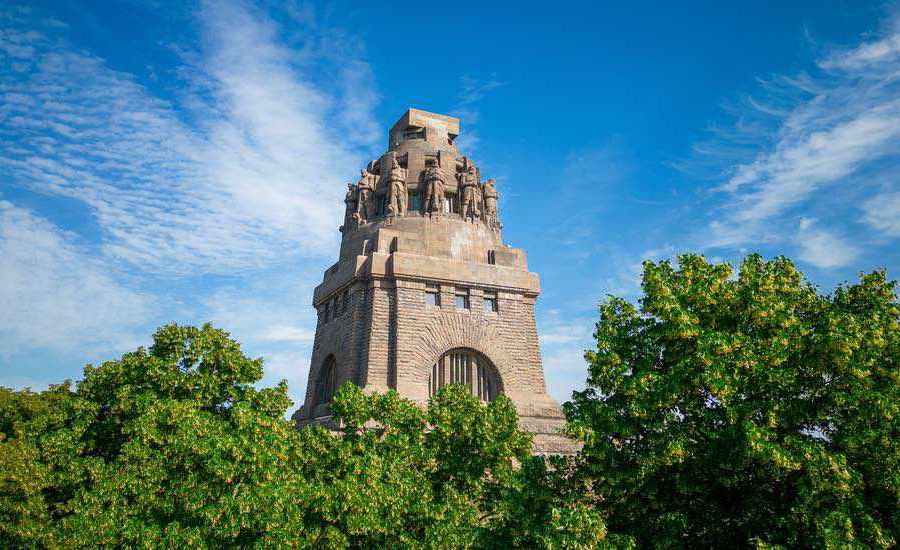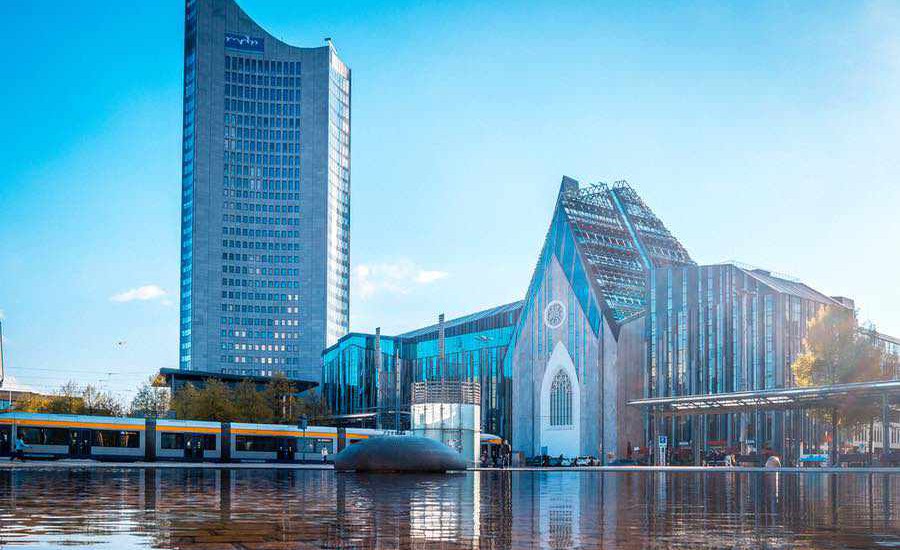Leipzig's impressive architecture
An exploration journey
Leipzig, the city of poets and thinkers, is also a true gem when it comes to architecture. In this historic and vibrant city, you will find an impressive mix of historic buildings, modern architecture, and innovative design concepts. From Hotel BIG MAMA Leipzig, located centrally at Leipzig Central Station, many of these architectural treasures are quickly and easily accessible. Let's explore some of Leipzig's most remarkable buildings and architectural sites:
Altes Rathaus
 Leipzig altes Rathaus ©Philipp Kirschner / Leipzig Tourismus und Marketing GmbH
Leipzig altes Rathaus ©Philipp Kirschner / Leipzig Tourismus und Marketing GmbH
The Old City Hall in Leipzig is a historic building with a fascinating past. It was built in the 16th century in the Renaissance style and served as the seat of the city administration for a long time.
The Old City Hall is an architectural gem, featuring a magnificent facade, intricately decorated towers, and an imposing clock. It is a landmark of the city and a popular attraction for visitors from around the world.
The interior of the building impresses with its elaborate ceiling paintings, grand halls, and historic rooms. Here, one can experience the history of Leipzig up close and gain insight into bygone eras.
Today, the Old City Hall houses various exhibitions and museums that introduce visitors to the history and culture of Leipzig. It is also a popular venue for festive events, weddings, and concerts.
The Old City Hall is not only an architectural masterpiece but also a symbol of Leipzig's long tradition and cultural heritage. It represents the city's pride in its history and its contribution to the development of the region.
Visitors of the Old City Hall can delve into the rich history of Leipzig and admire the impressive beauty of this historic building. It is a place that captivates both locals and tourists alike, creating a connection to the past while Leipzig continues to evolve and look towards the future.
Völkerschlachtdenkmal
 Leipzig Völkerschlachtdenkmal ©Maciej Waraksa / Leipzig Tourismus und Marketing GmbH
Leipzig Völkerschlachtdenkmal ©Maciej Waraksa / Leipzig Tourismus und Marketing GmbH
The Monument to the Battle of the Nations (Völkerschlachtdenkmal) in Leipzig is an imposing monument that commemorates the decisive Battle of Leipzig in 1813. The monument was built between 1898 and 1913 and is one of the largest monuments in Europe.
The Monument to the Battle of the Nations impresses with its monumental architecture and striking dome. It proudly rises above the surrounding landscape and is visible from afar. The monument symbolizes the victory over Napoleon Bonaparte and the contribution of various nations to the liberation of Europe.
Inside the monument, visitors can explore the halls and learn about the history of the battle and its significance for Leipzig and Europe. An observation platform offers breathtaking views of the city and the surrounding landscape.
The Monument to the Battle of the Nations is not only a historical monument but also a place of remembrance and reflection. It serves as a symbol of unity and strength among nations in difficult times and commemorates the sacrifices and courage demonstrated in the Battle of Leipzig.
The monument is a popular destination for tourists and locals alike. It provides an opportunity to delve into history and understand the significance of the Battle of Leipzig for the development of Europe.
The Monument to the Battle of the Nations is an impressive monument that embodies the history and pride of Leipzig. It is a place where visitors can experience history and admire the impressive architecture and symbolic weight of this significant monument.
Nikolaikirche
 Leipzig Nikolaikirche ©Adam Kumiszcza / Leipzig Tourismus und Marketing GmbH
Leipzig Nikolaikirche ©Adam Kumiszcza / Leipzig Tourismus und Marketing GmbH
The Nikolaikirche (St. Nicholas Church) in Leipzig is a historic church that plays a significant role in the history of the city and the country. It was built in the 12th century in the Romanesque style and underwent several renovations and expansions over the centuries.
The Nikolaikirche is primarily known for its role during the Peaceful Revolution in 1989. Thousands of people gathered here to demonstrate for freedom and democracy. The church became the starting point of the Monday demonstrations, which eventually led to the reunification of Germany.
The interior of Nikolaikirche impresses with its Gothic architecture, intricate frescoes, and impressive altar. The church also houses an impressive organ that is regularly used for concerts.
The Nikolaikirche is a place of reflection, spirituality, and cultural life. In addition to religious services, it hosts regular concerts, exhibitions, and cultural events. The church attracts both locals and visitors from around the world who want to experience the atmosphere of this historic building and learn about its significance to the history and culture of Leipzig.
Nikolaikirche is a symbol of peace, freedom, and the will for change. It reminds us of the importance of courage, unity, and the pursuit of a better future. As one of Leipzig's most famous landmarks, St. Nicholas Church invites visitors to experience history and engage with important themes.
Bundesverwaltungsgericht
The Federal Administrative Court
 Leipzig Bundesverwaltungsgericht ©Philipp Kirschner / Leipzig Tourismus und Marketing GmbH
Leipzig Bundesverwaltungsgericht ©Philipp Kirschner / Leipzig Tourismus und Marketing GmbH
The Federal Administrative Court (Bundesverwaltungsgericht) in Leipzig is the highest court in the Federal Republic of Germany for administrative disputes. It was established in 1952 and has since played a central role in the adjudication of administrative law matters.
The Federal Administrative Court is located in Leipzig and occupies a modern complex in the city center. It consists of various panels that deal with different areas of law, such as public construction law, environmental law, asylum law, and civil service law.
The task of the Federal Administrative Court is to make final decisions on administrative disputes and ensure legal certainty. It reviews the legality of administrative decisions made by federal authorities or certain other institutions.
The Federal Administrative Court is a place of adjudication where judges decide on complex legal issues. The court's judgments often have far-reaching significance and can be influential in shaping legal practice in Germany.
As a significant court, the Federal Administrative Court represents the separation of powers and the rule of law in Germany. It plays a crucial role in ensuring the rule of law and protecting the rights of citizens in the administrative sphere.
Therefore, the Federal Administrative Court in Leipzig is an essential institution in the German legal landscape and contributes to the development and interpretation of administrative law. It ensures that the administration acts in accordance with the law and helps strengthen the rule of law and democracy in Germany.
Panometer Leipzig
The Panometer Leipzig is a unique attraction that transports visitors into a fascinating world of giant panoramas. Created by the renowned artist Yadegar Asisi, it is an impressive artwork that depicts history and landscapes on a monumental scale.
Located in a converted gasometer hall, the Panometer provides a 360-degree view of the depicted scenery. The panoramas are masterfully designed, capturing historical events, natural wonders, or captivating places. They are so realistically crafted that visitors feel as if they are actually immersed in the depicted world.
The exhibitions at the Panometer Leipzig change regularly and cover a wide range of topics. From historical moments such as the Titanic or the Battle of Stalingrad to breathtaking natural phenomena like the Great Barrier Reef or the Amazon rainforest, the panoramas offer a unique opportunity to experience these places and events up close.
In addition to the giant panoramas, the Panometer Leipzig also offers informative exhibitions that provide background information on the depicted themes. There are also audio guides that accompany visitors through the exhibition, providing additional insights.
The Panometer Leipzig is not only an attraction for tourists but also a popular destination for local visitors of all ages. It offers a unique way to experience art, history, and nature in a completely new way.
The Panometer Leipzig provides an exceptional cultural experience that immerses visitors in a fascinating world. It is a place where imagination and reality blend, allowing for an unforgettable journey through space and time.
Baumwollspinnerei
Die Baumwollspinnerei Leipzig is an important cultural center and a vibrant hub for art, creativity, and culture. Originally built as an industrial complex in the 19th century, the Baumwollspinnerei was transformed into an impressive cultural area at the beginning of the 21st century.
Today, the Baumwollspinnerei houses a variety of galleries, studios, workshops, artist studios, exhibition spaces, and event venues. It is a place where contemporary art, design, architecture, and fashion converge, creating a creative environment.
The artists and creatives who work and exhibit in the Baumwollspinnerei represent a wide range of disciplines and styles. Here, you can discover contemporary painting, sculpture, photography, installations, performance art, and much more.
The Baumwollspinnerei is also known for its regular art exhibitions, events, and festivals. It hosts vernissages, art auctions, concerts, film screenings, and cultural events that bring the venue to life and attract visitors from all over the world.
The premises of the Baumwollspinnerei itself are impressive. With its historic industrial buildings, expansive courtyards, and characteristic brick facades, it exudes a unique charm and provides an inspiring environment for artists and visitors.
The Baumwollspinnerei Leipzig is a place where culture and creativity thrive. It is a center for contemporary art and an important meeting point for artists, art enthusiasts, and the local community. The premises invite you to explore the diversity of the contemporary art scene and experience a lively and dynamic atmosphere.
Universität Leipzig – Paulinum
 Leipzig Universität Paulinum ©unsplash.com
Leipzig Universität Paulinum ©unsplash.com
The Paulinum is a central building of Leipzig University and a symbol of education and science. It was designed as a new construction and completed in 2017 to replace the historic university building that was destroyed during World War II.
The Paulinum houses various facilities of the university, including the Aula (auditorium) and the university church. The Aula is an impressive venue used for academic ceremonies, lectures, conferences, and cultural events. The university church, also known as St. Paul's Church, is a place of reflection and also serves for religious services and events.
The Paulinum is an architectural masterpiece that combines traditional and modern elements. The building's facade is characterized by an impressive glass window that provides a view into the interior and creates a connection between the past and the present.
The Paulinum represents not only academic events but also the dialogue between science, culture, and society. It is a place of exchange and encounter where students, researchers, and the public come together to share knowledge, exchange ideas, and gain new perspectives.
The Paulinum is a significant symbol for Leipzig University and contributes to the vibrant and dynamic atmosphere of the campus. It stands for excellence in education, research, and teaching and represents the spirit of Leipzig University as an institution that creates, promotes, and disseminates knowledge.
Book your stay at BIG MAMA Leipzig now
